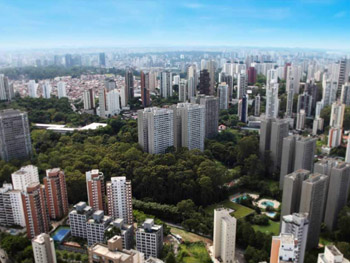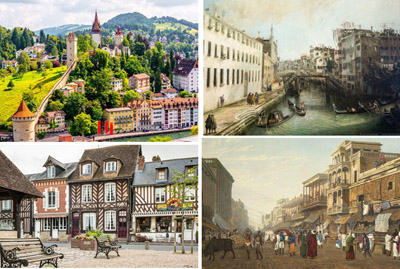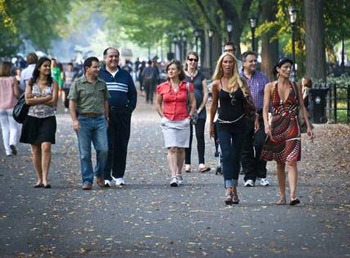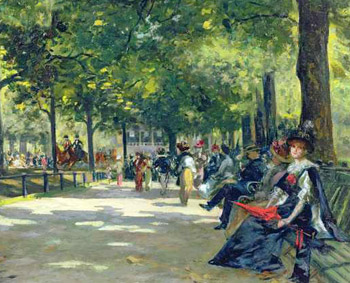Organic Society
 |
 |
 |
 |
 |
 |
 |
The Spirit of a City & the Spirit of a Country
If I analyze the human body as an organism, I can look at the liver as an organ of this organism. So also in a city, São Paulo for example, when I want to know its spirit, a neighborhood, such as Morumbi or Jardins, is an organ of this organism. Other neighborhoods, like Itaquera or São Miguel, are different organs of the same organism. But all of these organs end by interacting and forming a whole, which is the city.

 The spirit of a city is different from the spirit of a country. The spirit of a city restricts itself to reflecting some notes of partial aspects of reality. The spirit of a country, however, is the vision of the ensemble that its members have of the entire universe, of everything of life.
The spirit of a city is different from the spirit of a country. The spirit of a city restricts itself to reflecting some notes of partial aspects of reality. The spirit of a country, however, is the vision of the ensemble that its members have of the entire universe, of everything of life.
One could say that this vision goes from a way of looking at the stars to the way of closing one's eyes to sleep: Everything is different from one country to another. A country has a preponderant mentality that induces all its members to have an analogous way of seeing the universe, life, man and all the problems of man.
These mentalities of countries were much more diverse before the 19th century because means of communication were scarcer than they are today. People travelled much less, there was no radio, television, press or cinema – those were happy people!
They were not constantly bombarded by information about what is going on around the world. Each country lived as a separated reality, thinking about itself and its own problems and building its own vision of life. This vision of life encompassed a way of seeing and feeling things, a whole way of being, which at depth had a philosophy. In a certain sense of the word, philosophy is this.
Philosophy here should be understood as some dominant principles that act as the base to model almost everything one does. In normal language, we would call this someone’s philosophy. It is what causes a person to have a certain way of seeing things, of doing things. We can say that the way he walks, the way he coughs when he catches a cold, the way he sits at the chair when he is tired, all have a unity behind them that expresses the mentality of that individual in what is his innermost self, in what most characterizes himself.
One nation used to be different from the others, which could be seen by considering its monuments, its literature and the entire legacy it transmitted to us.
Until the 19th century, the nations still were quite different from one another, each one having its own mentality, its own way of being, its own philosophy and, thus, each one constituting a world apart from the others.
In a city there are neighborhoods that enter into a silent, instinctive contact with the others around it to influence one another. This mutual influence helps to create a mentality of the ensemble that is, properly speaking, the philosophy of that city.
These partial philosophies of the cities have affinities and will naturally generate a broader philosophy that encompasses all aspects of life. This is what we call the common mentality of a province and, finally, the mindset of a country.
The architectonic style proper to a people
An architectural style also had its own characteristics. There was, for example, the Greek style, which is super-well-known and super-eulogized as classical. How is a style formed? A style always expresses a mentality. The mentality had to be already incubated for the style to appear, so that the people would say: “That’s it!”
 In other words, there was a prior germination of the style in the subconscious of the people. They were not looking for a style – anyone who is always searching for a style does not find it. Rather, it is born in the spirit by a kind of spontaneous generation.
In other words, there was a prior germination of the style in the subconscious of the people. They were not looking for a style – anyone who is always searching for a style does not find it. Rather, it is born in the spirit by a kind of spontaneous generation.
In this way all the inhabitants of a region instinctively and eagerly prepare a style. When a man is particularly capable of grasping that collective eagerness and is gifted with artistic talent, he gives an architectonic expression for those sentiments. He creates it, but he acts as a spokesman for all those who live in that area. Under these conditions, what he builds is received with a general acclamation.
This is how a style spontaneously appears. Through the centuries the familiar conditions of life in an area – the language, the events, the traditions, the legends – influence the day-to-day life of the people in a homogenous way. During this time they mature and reach a stability that allows them to affirm themselves. When this process is fully developed, the style appears. This process applies not only to an architectonic style, but is reflected in the whole mentality through the arts and culture of the area. This is the spirit that the philosophers and the intellectuals will represent.
Assimilation & digestion
If we pay attention, when a person has strange ears or a peculiar nose, those outside of his family notice the defect much more than members of his family. Why does this happen? It is because those in his family see the defect day in and day out and end by believing it is not so ugly, but bearable. If there is a young woman in the family who is very beautiful, with time the family also come to believe that she is not so extraordinary. This is because the habit of seeing her daily breaks that first impression of the reality. In fact, they no longer react because they have assimilated those defects or qualities.

 Here we have the phenomenon of assimilation. Let us say a word about it.
Here we have the phenomenon of assimilation. Let us say a word about it.
Assimilation is a phenomenon in our spirit similar to digestion in our body.
A tasty fruit triggers my appetite. I bite into it and eat it. Some hours later, I am no longer thinking about it, but I am digesting it. That fruit can cause me well-being or malaise. By the phenomenon of digestion a part of that fruit becomes myself; a part of the aliments I eat continuously become a part of me. Also, something of myself is always leaving my body and being transformed into something else – cells, skin surface, threads of hair, etc. It is the phenomenon of loss, opposed and symmetrical to assimilation.
The public spirit reacts the same way. Without being aware of it, in a simple sightseeing excursion around a park, some persons can be assimilating and eliminating things that will be or were part of themselves. With this a people with the same psychological characteristics and the same formation, when placed before the same panorama, ends by forming – by assimilation and elimination – a public opinion.
Public opinion plays an enormous role in the orientation of the souls. When politicians are shrewd, they realize that the more they identify themselves with the customs and opinions of a certain area, the more they attract the people of that region. The more they ignore those customs, the more they are rejected.
The result is that the great majority of people from their childhood instinctively try to be similar to those around them and assimilate their mentality in order to have a pleasant relationship with them. This whole process is called the public opinion of a city, an area or a country.

Posted November 5, 2018

Two mentalities clearly seen in the neighborhoods of Morumbi (Brazil), above, and São Miguel, below

One could say that this vision goes from a way of looking at the stars to the way of closing one's eyes to sleep: Everything is different from one country to another. A country has a preponderant mentality that induces all its members to have an analogous way of seeing the universe, life, man and all the problems of man.
These mentalities of countries were much more diverse before the 19th century because means of communication were scarcer than they are today. People travelled much less, there was no radio, television, press or cinema – those were happy people!
They were not constantly bombarded by information about what is going on around the world. Each country lived as a separated reality, thinking about itself and its own problems and building its own vision of life. This vision of life encompassed a way of seeing and feeling things, a whole way of being, which at depth had a philosophy. In a certain sense of the word, philosophy is this.
Philosophy here should be understood as some dominant principles that act as the base to model almost everything one does. In normal language, we would call this someone’s philosophy. It is what causes a person to have a certain way of seeing things, of doing things. We can say that the way he walks, the way he coughs when he catches a cold, the way he sits at the chair when he is tired, all have a unity behind them that expresses the mentality of that individual in what is his innermost self, in what most characterizes himself.
One nation used to be different from the others, which could be seen by considering its monuments, its literature and the entire legacy it transmitted to us.
Until the 19th century, the nations still were quite different from one another, each one having its own mentality, its own way of being, its own philosophy and, thus, each one constituting a world apart from the others.
In a city there are neighborhoods that enter into a silent, instinctive contact with the others around it to influence one another. This mutual influence helps to create a mentality of the ensemble that is, properly speaking, the philosophy of that city.
These partial philosophies of the cities have affinities and will naturally generate a broader philosophy that encompasses all aspects of life. This is what we call the common mentality of a province and, finally, the mindset of a country.
The architectonic style proper to a people
An architectural style also had its own characteristics. There was, for example, the Greek style, which is super-well-known and super-eulogized as classical. How is a style formed? A style always expresses a mentality. The mentality had to be already incubated for the style to appear, so that the people would say: “That’s it!”

Organic architectural styles: from left top, Lucerne, Switzerland; Oslo, Norway; Calcutta, India; a village in Normandy, France
In this way all the inhabitants of a region instinctively and eagerly prepare a style. When a man is particularly capable of grasping that collective eagerness and is gifted with artistic talent, he gives an architectonic expression for those sentiments. He creates it, but he acts as a spokesman for all those who live in that area. Under these conditions, what he builds is received with a general acclamation.
This is how a style spontaneously appears. Through the centuries the familiar conditions of life in an area – the language, the events, the traditions, the legends – influence the day-to-day life of the people in a homogenous way. During this time they mature and reach a stability that allows them to affirm themselves. When this process is fully developed, the style appears. This process applies not only to an architectonic style, but is reflected in the whole mentality through the arts and culture of the area. This is the spirit that the philosophers and the intellectuals will represent.
Assimilation & digestion
If we pay attention, when a person has strange ears or a peculiar nose, those outside of his family notice the defect much more than members of his family. Why does this happen? It is because those in his family see the defect day in and day out and end by believing it is not so ugly, but bearable. If there is a young woman in the family who is very beautiful, with time the family also come to believe that she is not so extraordinary. This is because the habit of seeing her daily breaks that first impression of the reality. In fact, they no longer react because they have assimilated those defects or qualities.

Different assimilations in a walk in the park today, above, and in the 19th century, below

Assimilation is a phenomenon in our spirit similar to digestion in our body.
A tasty fruit triggers my appetite. I bite into it and eat it. Some hours later, I am no longer thinking about it, but I am digesting it. That fruit can cause me well-being or malaise. By the phenomenon of digestion a part of that fruit becomes myself; a part of the aliments I eat continuously become a part of me. Also, something of myself is always leaving my body and being transformed into something else – cells, skin surface, threads of hair, etc. It is the phenomenon of loss, opposed and symmetrical to assimilation.
The public spirit reacts the same way. Without being aware of it, in a simple sightseeing excursion around a park, some persons can be assimilating and eliminating things that will be or were part of themselves. With this a people with the same psychological characteristics and the same formation, when placed before the same panorama, ends by forming – by assimilation and elimination – a public opinion.
Public opinion plays an enormous role in the orientation of the souls. When politicians are shrewd, they realize that the more they identify themselves with the customs and opinions of a certain area, the more they attract the people of that region. The more they ignore those customs, the more they are rejected.
The result is that the great majority of people from their childhood instinctively try to be similar to those around them and assimilate their mentality in order to have a pleasant relationship with them. This whole process is called the public opinion of a city, an area or a country.

Posted November 5, 2018
Organic Society was a theme dear to the late Prof. Plinio Corrêa de Oliveira. He addressed this topic on countless occasions during his life - at times in lectures for the formation of his disciples, at times in meetings with friends who gathered to study the social aspects and history of Christendom, at times just in passing.
Prof. Plinio
Atila S. Guimarães selected excerpts of these lectures and conversations from the transcripts of tapes and his own personal notes. He translated and adapted them into articles for the TIA website. In these texts fidelity to the original ideas and words is kept as much as possible.
______________________
______________________
 Volume I |
 Volume II |
 Volume III |
 Volume IV |
 Volume V |
 Volume VI |
 Volume VII |
 Volume VIII |
 Volume IX |
 Volume XI |
 Special Edition |
 Special Edition |



